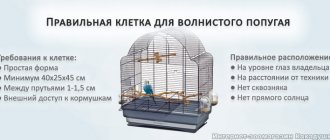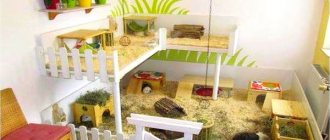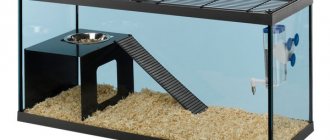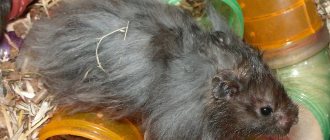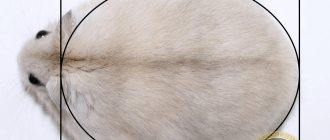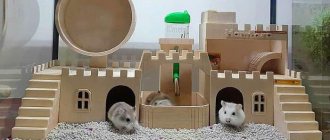- home
- Housing
12.04.2018
Hamsters are easy-to-keep animals that do not require much care. Even children can look after them. The decision to acquire a shaggy pet is made with all responsibility, and the first priority is to find him a spacious and comfortable house.
Requirements for cages for keeping rodents
Housing for comfortable living of hamsters has its own characteristics.
Size and shape
The main requirements for an animal's cage relate to its size. According to experts from different countries, keeping a hamster requires organizing a large space. At the same time, different zoologists call different numbers. But most researchers agree that a pet's cage should be at least 2900-6000 cm², and its height should be 30 cm or more.
Pet stores sell small housing for hamsters, but for a comfortable life for a rodent, it is better that the enclosure is approximately 70x80 cm or slightly smaller.
The most convenient cells are square and rectangular. A spherical-shaped home is more difficult to clean.
Distance between rods
If the hamster's place of residence consists of separate rods, the distance between them should be small. It depends on the size of the pet. The main task is to prevent the animal from getting out.
The distance between the rods should be small.
The smallest, dwarf breeds or cubs should live in housing with a size between the bars of no more than 5-6 mm.
For Syrian hamsters or larger individuals, the rods should be spaced no more than 10-12 mm apart.
Design features
A house for a rodent can be solid - made of wood, glass or plastic - or made of rods, gratings, nets.
Advantages of continuous housing:
- the animal is reliably protected from other pets living in the house - for example, cats;
- the hamster will not fall while climbing walls.
However, there are some disadvantages:
- odors accumulate faster;
- housing will have to be cleaned more often;
- a solid structure is less ventilated.
Advantages of a house made of twigs:
- the cage is well ventilated;
- The hamster’s housing is easy to clean;
- you can observe the actions of the animal.
The hamster's housing is convenient to clean, the cage is ventilated.
It is better when the bars are located horizontally so that the pet can climb them like a ladder. But it is desirable that the cage is not high, because... the animal may fall.
But you need to take into account that a hamster can chew through soft metal or swallow paint. It is better to buy an enclosure made of durable rods coated with a stainless steel compound. In addition, in this case, hamsters can climb walls that consist of horizontal rods and fall from a height. This may cause injury.
In addition to simple enclosures, they can be multi-story, modular, with shelves for climbing, etc.
In multi-storey cages, the area of each level must be no less than the previously specified dimensions. It is better to choose solid ceilings so that the animal cannot get injured. Each level is connected to the other using stairs or wide tunnels.
Material of manufacture
Solid structures are most often made of durable plastic. It must be non-toxic, because... the hamster may chew on protruding parts. Most often, housing for pets is made of acrylic, because... Thanks to its finely porous structure, it is easy to clean.
The main disadvantage of this material is the absorption of odors. It is difficult to eliminate this unpleasant phenomenon even with the help of modern means.
Some animal owners prefer to keep hamsters in a glass aquarium. This is a bad option because... such a place to keep an animal is poorly ventilated. To improve ventilation and prevent fogging of the walls, the width of the aquarium should be greater than the height.
A glass aquarium is poorly ventilated.
Some dwellings are made of wood. It should be remembered that a hamster can chew through its house. Its walls should be thick, made of hard rock.
There are combined products that are made from different types of materials.
The best material is considered to be nickel-plated metal, from which rods for homes are made. It is easy to wash and does not absorb odors. This habitat is well ventilated.
The tray is hygienic, even if it is made of plastic, since it is covered with a layer of filler of at least 5 cm.
However, cages with metal bars have a drawback: a lot of noise from the hamster's movements.
How many hamsters can live in one cage?
Small breeds of hamsters (except Djungarian) can be placed in one cage. Bergman's hamsters are considered the most social. But keeping several animals together will require more space than keeping one.
What to pay attention to
When buying a hamster cage, keep these tips in mind.
The size of the cage for a Syrian hamster is very important. The dimensions of the housing base are more important for an animal than the number of floors. According to European ratologists, the optimal dimensions of the bottom of the product are 500x300 mm. Housing that is too cramped can be harmful to your pet's health. He is at risk of obesity and physical inactivity. The normal lifespan of a hamster is about 2 years, and in a cramped room the animal will not reach the age of one and a half years. The optimal distance between floors is 300 mm. The cage door must be wide enough to allow the pet to be removed without difficulty. It is desirable that the pallet be solid. The mesh tray may cause injury
In addition, the monolithic plastic tray is easy to clean. Pay attention to the spacing between the rods. The most preferred distance is 5-10 mm.
If you purchase a cage for breeding hamsters, keep in mind that young animals can freely crawl into the 7 mm gap between the bars. Therefore, the distance between adjacent cage bars should be 5 mm.
How to choose a cage for a hamster
To choose a suitable cage for a pet, you need to focus on the general requirements for the animal’s home and its breed. Small decorative hamsters can live in a small cage, but large individuals will need a more spacious home.
To prevent your hamster from becoming obese, you need to equip its habitat with accessories that allow it to actively move: a running wheel, stairs, tunnels.
For rest and sleep, a plastic house is installed inside the home.
Large hamsters need a spacious cage.
Djungarian hamsters
One of the most popular breeds is Djungarian hamsters. These are small and nimble animals. Even the largest male barely reaches 10 cm in length. Their weight is about 50 g. Among breeders they are considered a friendly breed.
Djungarian hamsters live only alone.
Syrian hamsters
Representatives of the Syrian breed are larger than their relatives. Their weight reaches 1245 g, and their height is 13.5 cm. Accordingly, their cage should be larger in size - at least 50-70 cm in length with a width of 40 cm and a height of at least 30 cm.
An interesting feature of hamsters of this breed is the ability to respond to a nickname. Only Syrian hamsters have this ability.
With good care, these hamsters can live up to 4 years. It is necessary to provide all the conditions for a comfortable stay for the animal and equip its home with devices that maintain its shape.
Popular goods
Nowadays, specialized pet stores sell all-inclusive mansions for rodents, which already have the necessary furniture. To the question “how much does a hamster cage cost?” It’s difficult to answer, since the price range is very wide.
We present you the most popular models:
- Zoomark. Two-story and three-story wire cages for hamsters. Their disadvantage is the lack of furniture. Some models have ladders. Advantage – low cost (from 500 rubles);
- IPTS "Alex". Spacious dwelling, equipped with a running wheel, drinking bowl and dining room. In such an “apartment” the Djungarian hamster will feel very at ease. Costs from 3000 rubles;
- Zolux Rody lounge solo. In addition to the drinking bowl, wheel and feeder, there is a small labyrinth with pipes and a balcony for swimming (it must be filled with dry sand or sawdust). You don’t have to be afraid that your pet will run away from the balcony; it is closed, equipped only with holes for air access. The owners will like the stylish design. Cost – from 2500 rubles.
- Ferplast. The company's products are varied, but owners prefer to buy the Ferplast “DUNA FUN” model for hamsters. It is two-story, large in size, contains cutlery, a wheel, a long labyrinth, and a shelter on the 2nd tier. Price from 5200 rubles.
Dunes for rodents are much less common on sale. This is a prefabricated plastic container with holes on the surface of the lid. Plastic cages for Syrian and Djungarian hamsters are sold with furniture and have two levels. The downside of the dunes in front of the lattice apartments is poor air circulation.
The best commercial hamster cages
The retail chain offers a large assortment of ready-made cages for rodents. Many of them are equipped with devices for the full life of the animal: a feeder, a drinking bowl, a house for sleeping and means for outdoor games. They imitate the life of an animal in nature.
Savic Geneva A5068 60x29x44 cm
This is one of the best housing models for animals. Its dimensions are 60x29x44 cm. This two-story cage for hamsters is equipped with everything necessary: the set includes a drinking bowl, a feeder, and a wheel for games. The upper and lower floors are connected by a staircase along which the hamster can run and climb. It is easy to change the filling in the cage - the tray slides out without causing disturbance to the animal.
Savic Geneva A5068 60x29x44 cm is the best model for a hamster.
A variety of colors will allow you to fit the hamster’s housing into the interior of the room: there are pink, black, and blue models.
Triol 31003a 40x26x53 cm
This beautiful cage consists of 3 floors connected by tunnels. The housing arrangement is designed for animals leading an active lifestyle. Equipped with everything necessary - drinking bowl, feeder, wheel. There is a small house on the side so that the pet can rest in it.
But large individuals can get stuck in the tubes connecting the floors.
Therefore, the only drawback of this design is that it cannot be used for Syrian hamsters.
Ferplast Dragster 50x35x25 cm
Children will love this cage. It is made in the shape of a car and is divided into 2 levels by a plastic partition. The Ferplast Dragster hamster housing has everything you need - a feeder, a house, a wheel. There are holes for connecting additional modules. This unusual cage is designed specifically for children.
Ferplast Dragster 50x35x25 cm contains a feeder, a house and a wheel.
Credo 47x30x37cm
The product of this brand is liked by many owners of small rodents. There are many tunnels, labyrinths, and passages for the active life of the animal. The Kredo design includes 2 floors connected to each other by a labyrinth tube. The cage is made of metal rods with a special coating. There is a handle on top for moving the home.
Triol Studio 33x21x23
This cage is small in size, so it is best used for keeping small animals. However, her space is well equipped. Comes with everything you need. The design of the Triol product includes plastic side surfaces and a metal middle part made of rods. The small area of the cell is compensated by the presence of tunnels.
Triol Studio 33x21x23 is a small cage.
Walks
The hamster should be periodically given the opportunity to roam. For these purposes, special clothing must be purchased. You can also buy additional accessories. It’s worth understanding what a harness and a walking ball are.
Walking ball
Non-toxic plastic is used to produce the balls. It may vary in color. The ball has holes for paws and ventilation. Hamsters will be able to get used to such an accessory quite quickly. They will first need time to figure out what the system is. After some time, the hamsters will begin to roll around in circles. They will need a little more time to learn how to control the ball.
It should be noted that a harness is not as secure as a ball. In it, the pet will not be able to climb into any gap, from which it will then have to be taken out. However, predators will be able to cut through the plastic with their sharp claws and injure your pet. Therefore, it is not recommended to leave him alone.
Using a leash
Special clothing for walking and a harness may be purchased. It is a simple leash. The harness clings either to clothing or directly to the pet. In this form you can walk with a small animal. A leash ensures that the animal cannot hide behind cabinets.
However, clothing and harnesses require certain skills. Putting them on your hamster is not as easy as it might seem. You need to hook the leash so that it covers the neck and chest. The harness should not press too hard.
Naturally, as a dog, even a harness will not allow you to walk your hamster. He will lead you during walks. You are required to ensure that your pet does not get entangled or suffocate. Therefore, constantly check whether the harness has begun to squeeze the neck.
How to make your own rodent cage
Pet owners who do not have the opportunity to purchase ready-made housing for their animal are thinking about how to make a hamster cage with their own hands. At home it is made from scrap materials.
From plastic containers
To make your own cage, you will need a plastic bottle with a capacity of 10 liters. It is placed on its side and in the upper part a marker is used to indicate the dimensions sufficient to allow a running wheel to be placed inside. Then carefully cut a hole with a knife. You can separate this part of the plastic bottle completely or leave it as a cap. Then you need to cut holes in it for ventilation.
Using a hot soldering iron, pierce the bottom of the bottle in the middle so that the wheel can be secured.
The filler is placed through the cut hole, a sleeping house, a feeder and a drinking bowl are installed on top.
For outdoor games, you can build a tunnel from several 5-liter plastic bottles connected to each other through cut holes (see photo):
On the side of each corridor you need to make a passage for the hamster. To create ventilation, all bottles are pierced with an awl in several places.
You can use a plastic container to create a cage.
From containers
In order to organize the hamster's living space, you can use a large plastic container with a lid measuring at least 60x40 cm, and preferably 80x60 cm. It is sold in a hardware store.
Large rectangular holes are cut out in the side and lid. They are covered with a mesh with a mesh size of no more than 1 cm², which must be secured with ties or screws. Filler is poured into the bottom of the container.
From the aquarium
A low and wide aquarium can be used as a temporary home for a hamster. But do not forget that glass does not allow air to pass through, so the aquarium is not suitable for keeping a hamster permanently.
From boxes
Making a cage for an animal out of boxes is inconvenient, since the hamster will quickly chew through it. It can only be considered as a temporary place for the animal to stay, for example during the cleaning period.
A hamster will quickly chew through a cardboard house.
Made of wood
It's easy to assemble a rodent cage from scraps of floorboards. To do this, 2 short pieces of 40 cm each and a long piece of 60 cm are placed on the edge, forming the perimeter of the future cage, and secured with wood screws, as shown in the video:
Then moisture-resistant chipboard is laid on top and also secured with screws.
Turning the structure over, make the second and third rows in the same way. They are connected by metal threshold strips. Glass is inserted as the front wall or a mesh is secured.
To improve ventilation, you need to drill several holes from different sides in the wooden walls of your home.
This homemade hamster cage meets the requirements for keeping animals.
Use of litter
Litter refers to the substrate that fills the bottom of the cell. For example, you can use hay or sawdust. In extreme cases, sand will do. Clothes will also come in handy for these purposes. It is worth understanding that the quality of the litter plays an important role. The hamster can dig in it. In addition, sand or sawdust can absorb the animal's urine.
At the present stage, there are a huge number of different options. As already mentioned, you can use the traditional option: sawdust, sand and hay. Make sure that the sawdust is not pine or cedar.
Using hay, sand or sawdust, you need to make a layer whose thickness will be 6 cm. Again, you need to be guided by the size of your pet. Keep in mind that hamsters will bury themselves in sand or sawdust.
How to connect two cells
Sometimes it becomes necessary to connect 2 cages: for example, to clean one of them or move an animal into a carrying bag. To do this, you can use tunnels and special adapters from the round hole of the tube to the square exit from the cage, which are sold in a pet store.
Two cells can be connected by tunnels.
But you can adapt homemade devices for transferring a hamster, using old corrugated pipes from a vacuum cleaner or plastic bottles for this purpose. The main condition is not to create sharp corners so that the animal cannot get hurt.
The simplest device uses a ladder made of twigs to move rodents between levels and a plastic bottle. Using wire cutters, remove part of the metal crossbars along the diameter of the future pipe to create a tunnel.
The bottom and neck of the bottle are cut off and connected to the second cage.
Video “Walking Accessories”
The video will talk about what a harness for a pet animal can be like. Be sure to watch it.
Sorry, there are no surveys available at this time.
Was this article helpful?
Thank you for your opinion!
The article was useful. Please share the information with your friends.
Yes
No
X
Please write what is wrong and leave recommendations on the article
Cancel reply
Rate the benefit of the article: Rate the author ( 2 votes, average: 5.00 out of 5)
Discuss the article:
Setting up a hamster cage
For sleep and rest, a small house is placed inside the animal’s home. Mandatory accessories include a drinking bowl and a feeder. For motor activity of the animal, a running wheel is placed in the cage. All other toys and devices are installed at the request of the owner. But don't forget that hamsters love to make holes, dig, move and play.
Filler is poured onto the bottom of the cage to absorb moisture and odors.
Filler selection
Previously, when special litter for keeping hamsters was not sold, scraps of newspaper were used. However, such bedding contained printing ink, which was harmful to the animals.
Fine sawdust is the most suitable material for the cage.
The use of napkins and paper towels is allowed. However, they should not be dense or have sharp edges that pose a danger to the pet.
Do not use cotton wool or scraps of fabric, because their fibers can become wrapped around your hamster's legs and cause injury.
The most suitable qualities for the underlying layer are fine sawdust or corn husks. They absorb moisture well and do not concentrate odors. Pet stores sell these bulk materials, made specifically for filling trays in animal cages.
Containers for food and water
It is better to use a porcelain bowl or other heavy container as a feeder, because... the hamster can turn it over.
For the same reason, drinking bowls are most often placed outside the cage, leaving only the spout inside for drinking moisture. Pet stores offer nipple, ball and vacuum water devices. They are attached to the outside of the cage and will not take up space inside.
Accessories and toys
A rodent's leisure time should be varied. Pet stores have various devices for animal games and activities: houses, ropes, drums, balls. A hamster can climb stairs or chew on a mineral stone, and a fabric hammock will not only be an excellent toy for your pet, but also a decoration for the cage.
The rodent must have organized leisure time.
Rodent toilet
Some hamsters are so clean that they perform their natural needs in only one place. In this case, a small container is placed there to collect waste. Then you will have to clean the cage less often.
Size
In nature, in their natural habitat, hamsters of all breeds are extremely active and energetic, because their life directly depends on the ability to run quickly: they need to go scouting for new food, collect it and take it to their burrow, simultaneously escaping from a predator.
Pets do not need to do all this, but nature takes its toll and requires that energy be spent moving around the cage; accordingly, the rodent should have enough space for this. In addition, he will need separate areas for toileting, eating, sleeping and storing supplies.
The recommended cage size for keeping one individual is 30x30x45, but more is possible. If you are limited in space, you can take a closer look at two-story options, but young and active animals often fall from the second floor, which can lead to injury.
